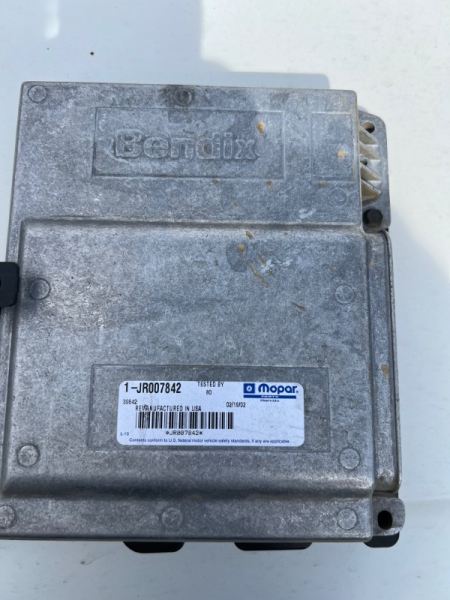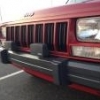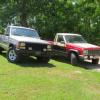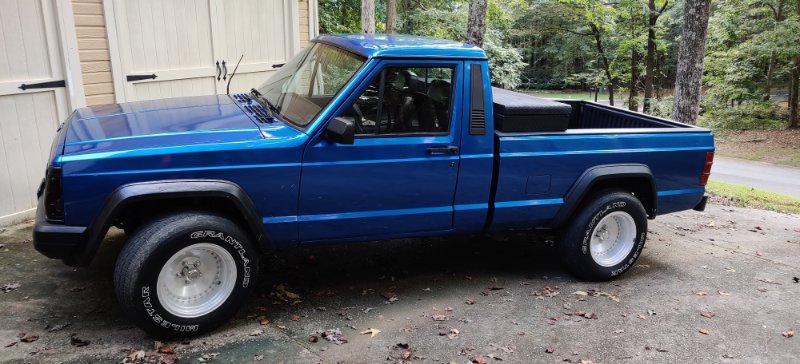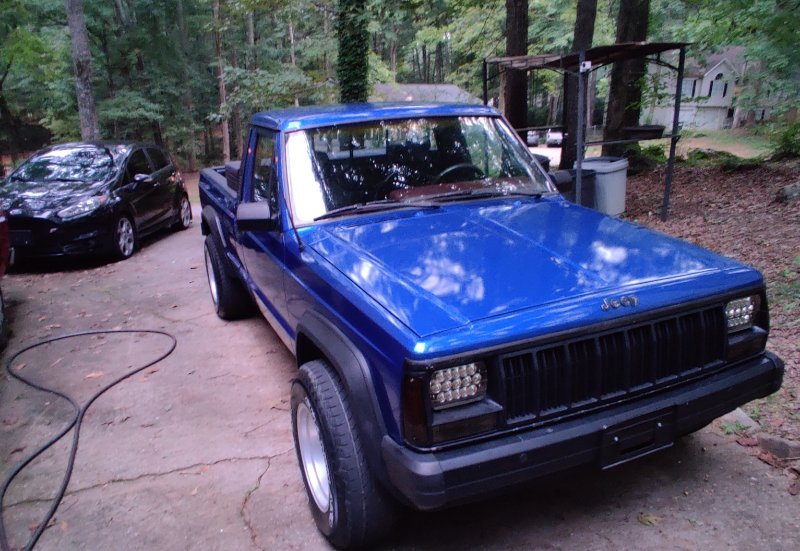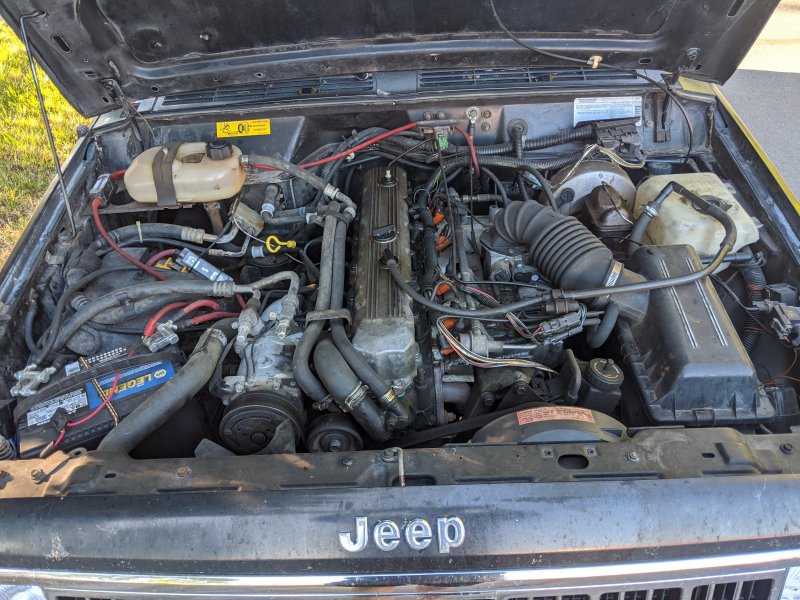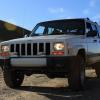Search the Community
Showing results for tags 'renix'.
-
Okay so my search hasn't exactly been the most fruitful of the following question. What are the dimensions of a Renix 4.0 TPS bolt and IAC bolt? I wanted to replace the bolts because I lost one, the other TPC bolt started stripping at the torx head, and the IAC bolts somehow have a triangular shape to the shaft. On a whim yesterday, I took the TPS bolt to the hardware store, and it seemed to match with an M5, but the M5s that I took home seem too big. Today I returned and noticed that the TPS bolt will thread into both the M5 and the 10-32 gauges. But when I compare the bolt to what they have, it seems the threads don't sawtooth together with the 10-32 bolts. Or maybe it was 8-32, heck I dunno, I've got so many numbers already to memorize... The IAC looks to have a larger diameter shaft. '89 4.0 Renix, by the way.
-
I just pulled an ECU out of a 90 Cherokee (doing the upgrade for my 88 MJ) and noticed it doesn’t have the factory sticker on it but one that says it’s a Mopar rebuild from 2002. Is there anything special with these (I heard somewhere that there was a Mopar upgraded ECU at one point?) or is it the same specs as an OEM computer? Thanks!
-
I'm probably going to at least ATTEMPT to try and develop a homebrew TCU. But first, I'd like to have what the common issue with the TCU's, and what makes them $#!& the bed. Is it a hardware issue? Is it a software issue? Has anybody else attempted this? I am fairly new to this forum, and I'm sure a lot of you fellas have already looked at the threads way more than I have, but again, I'd like to troubleshoot the problem so I can decide how far I want to take this. If it works out, I'd like to post the entire process and open-source it so people don't get scalped on renix TCU's. A build list, an assembly guide, and a cost amount, assuming that this would come to fruition. Any help would be appreciated. Thanks in advance.
-
So I plan on doing the 4wd conversion to my 1989 2wd automatic 4.0L MJ. I obviously want the cheapest route and don't mind the work needed. I guess my question is, if i found another xj within the years 87-90 (renix) does everything swap right in? besides the rear driveshaft (I know that would have to be re-sized). I also have an automatic tranny right now and keeping it would be less costly and less work than getting a manual trans but would my ax4 be a good match up for a transfer case? Or would I have to swap the trans from a donor with a 4x4 auto? This is my first big project for me so help would be appreciated! :thumbsup:
-
FullSizeRender.MOV So I went to boost my truck few days ago and I accidentally put the booster cables on backwards and then got in and turned it over, it made a horrible zing noise from the starter and my gauges went all crazy, I got out and changed the cables to normal and the gauges went back to normal but now it just turns over and sometimes starts and idles fine and even Revs fine but dies after 5 seconds, my relays also have a clicking to them after I try start it. All my fuses look fine and I even have Ksuspensions 250A fuse between the fuse block and the alternator and it blew so maybe that saved something. I already put in a different fuse block and didn’t change anything. I attached a video of the truck running fine but right after he video stops the truck dies instantly IMG_7300.MOV IMG_7300.MOV
-
Codename Bumblebee: Continued A currently quite short build thread by Minuit I've been looking for a second project for some time. My silver '91 has been my daily driver for years and is at the point where it's getting hard to call it a project truck. If you've been keeping track of this truck's previous build thread, you'll know that this truck's previous owner, relyt120, never got a chance to do much with it and recently needed to sell it. Coincidentally he put it up for sale at the exact time I happened to have both the means to buy it and the time to work on it! Not only that, but I'd had my eyes on a manual vehicle of some sort. The previous owners (with the exception of relyt120) have been unkind and downright neglectful to this truck, and it needs a lot of love. However, the most important things are in place - to get it up to snuff I have a lot of small things to do, and some major surgery is needed. Here are the specs: 1989, short bed, Renix 4.0, AX-15 internal slave, open D35 rear end, ~150,000 miles. Let me be clear: I'm very much aware I have a lot of work to do, but I know what I'm doing and I'll do things right The Good: - It has the AX-15, and it shifts very well - The engine, while noisy, runs fairly well. - Besides the floor pan, it's almost completely rust free. The body on this truck except for the floor pan is in some ways better than the '91. - It's a Comanche! - I got it for a very good price. - It has a number of upgrades already done, including bucket seats, switched electric fan controls, Volvo fuel injectors, and upgraded grounds. - It theoretically has air conditioning. - I got tons of parts with it, including two Comanche interiors. - It has a surprisingly soft ride. - It's a blank canvas for whatever I want to do to it. Unlike the '91 I don't feel any obligation to keep it original. The Less Good: - Electrical issues abound, including non-functional reverse lights, brake lights(!!!), and a completely nonresponsive instrument cluster. - The engine sounds like hell and makes barely acceptable as of January 2019, zero as of May 2019, barely acceptable oil pressure. - The driver side floor pan and some of the transmission tunnel is rusted through likely due to a long ignored clutch fluid leak. I have a patch panel for the driver side floor. - The front end is in need of work. The truck has a significant front end shimmy - not quite death wobble, but definitely something is very loose. - It has massive vacuum and exhaust leaks. - Renix Cooling System. 'Nuff said. The pressure bottle of course leaks and a replacement has already been ordered. - The windshield is toast. - It's mind bendingly hideous. - The parking brake is missing. The Plan (more detail in Post 14): - Fix brake lights before I drive it on the road again - Fix all critical electrical circuits: brake lights, gauges, reverse lights. - Replace the Renix pressure bottle. - Re-install the interior. - Refresh front suspension. as of August 2019, done... more or less. - Repair the driver side floor. - Convert cooling system to the open loop High Output version. as of September 2019, it's been thoroughly de-Renix'd. - Turn the truck a single color, with chrome trim. - Air conditioning! Edit 12/2/16: Unlike my other build thread, the OP will be updated continuously and serve as a summary of my progress.
- 60 replies
-
- frankenjeep
- project
-
(and 2 more)
Tagged with:
-
No need to say it, but I'm new here. Just picked up my first Comanche last week and I love it. The guy I bought it from had 4 of them sitting in his yard. 2 for parts, and 2 to drive. He painted this one himself and I love the color man. It definitely has some issues, but the body and interior are in great shape. I've never driven a 4-speed before.. I can't say I love it but honestly it's not bad. The rear end has some clunking on decel, and according to the seller it's the pinion bearing. It drove fine on the way home after I bought it, but I know I need to fix the rear end asap. 2 days ago it randomly started running rough and misfiring at idle. I did a lot of research on here and I'm so thankful for this community, otherwise I would have wasted a lot more time and money on it than I needed to. I found 2 cracked vacuum lines (one that runs from the throttle-body to the vacuum reservoir, one that runs to the firewall) and after replacing those and doing a basic tune-up it runs fantastic. I still have a lot left to do though as I've found several other issues. Things I've done to it since I bought it Oil Change Plugs, Wires, Cap & Rotor Coolant Temp Sensor (for temp gauge) Serpentine Belt Vacuum Lines Things I need to work on next Rear End - Planning to open her up and see what I need to fix. The Dana 35 appears to be pretty easy to work on from what I've seen. This is going to be the first thing I fix. I have tools to help me get the crush sleeve set and I don't think it will be a problem outside of working the old bearing races out. Universal Joint - After inspecting my rear end I actually found out that the vibrations and knocking were coming from a loose universal joint. Clutch Master and Slave - I was happy to find a few drips of clutch fluid on my floor-mats and noticed that it has been dripping on my fuse box. The master cylinder will have to be replaced. I also noticed what looks like fluid under the transmission. I fear that the internal slave on my AX4 might be leaking too.. This is going to be my least favorite job I think. Rear Main Seal - I doubt this thing has been replaced since 1987. I found a video that shows how to do it without removing the crank, so I am probably going to try that first. I might as well to it at the same time as the slave cylinder, so it's going to be a nice weekend job. Water Pump & Thermostat - There doesnt appear to be anything wrong with these, but I think its safer for me to replace them now before I end up having an issue. It's a reverse rotation water pump from what I've gathered. Valve Cover and Oil Pan Gaskets - I'm going to have to replace the oil pan gasket when I change the rear main, so may as well change the valve cover gaskets too. Front parking lights - these don't work right now. I think a bulb is missing from one side. Not sure about the other. AX4 Output Shaft Seal - Discovered this was leaking while replacing the U-Joint. Horn - The horn button on my wheel does not engage the horn. This could be several things, so Ill have to troubleshoot. After I get these all done I should have a pretty solid truck. I'm really excited. I get a good bit of attention driving her around town. Actually had 2 guys tail me on the way home one day which was fun... I don't know for sure but judging from what I saw I was worried they were going to try to jack the truck Anyways.. Happy to be here! I'll update things as I go. See you guys around! P.S. Vacuum Lines are definitely the first thing people should check if the engine is running rough... Most of you seem to know that already, but I didn't at first.
-
I want to put the 97+ dash in my truck, but I don’t want to convert to OBD ll. Has anyone done this or know a way to retain the Renix engine management and gauges while swapping the interior? I thought about using a custom gauge cluster in a blank template that fits the newer dash, but I wasn’t sure which gauges work with Renix. ideally I just want to update the interior and allow the ability to run a double din radio with the already existing center dash swap that’s out there. Any ideas would be helpful!
-
No better place then here, to throw this question on the chopping block. Does RENIX Engine Control Units (ECU) use Volatile Memory? Myself, I think YES. Following are three (3) reasons why: 1) RENIX ECU has "Hot at all times" (C201_B7) circuit. WHY? 2) If ECU doesn't know Closed Throttle (CT) percentage, what happens during the next START, when someone has their fat foot pushing down on the gas pedal. Will that become the new CT percentage? 3) Does Long Term Fuel Trim (LTFT) really just stand for Next Term Fuel Trim (NTFT)? I don't think so. If that was the case, you'd only need Short Term Fuel Trim (STFT). Now are all ECU's created equal (early ECU's vs later ECU's)? As new strategies and improvements came along during the RENIX years, they were incorporated into the ECU's. Could this be the reason why some say YES to "volatile memory", while others say NO? So this is a good time to sharpen up your butcher knife and start swinging away.
-
88 Jeep Comanche Eliminator Short Bed 4.0 manual with 188010 miles. 4.0 with AX15 and 231 transfer case. Dana 30 front and Dana 35 rear axle. Resides in US Lakeview Oregon. This is currently my daily driver and trail rig. It runs and drives great after all of the work I put into it. Still updating and restoring what I can. Here is what has been done: Dana 30 front axel Dana 35 rear axel Replaced peugeot transmission with AX15 and converted to 4x4 with NP231 transfer case Bluetooth sound system w/8" sub Replaced slave cylinder Replaced clutch master cylinder and hydrolyc hose Replaced rear main seal Replaced u-joints Replaced throttle position sensor Replaced throttle body Replaced clutch and pressure plate Replaced starter Replaced harmonic balancer Replaced All ground wires and connections as well as battery cables and terminals Replaced air filter with high flow "Green" filter New fuel filter Installed 4 hole Volvo injectors It is straight piped with knock off flow master muffler. New black 15" steel wheels Light harness from K Suspension Halogen light conversion with Sylvania bulbs All gauges, lights, and electrical work. Have parts and need to install: ECU from a 91 Jeep XJ New Power steering pump I need: Front driver bucket seat with manual slider Seat belt buckle (driver) Window crank (grey) Sun visors (grey) Rear bumper Lund sun visor (in time)
-
So I recently get my Comanche back on the road after 18 years (yay!) but, I’m having a reoccurring issue. If I cold start it, it will rev up to about 2k then drop to about 500ish, then it will stumble and jump to 750 where it will idle consistently. If you rev it up past 2500ish, when it drop back down, it will stumble then die. I’m not sure what would be causing this, as it runs great at higher rpm, and had plenty of power. I do, however, think it’s running rich, because it smells a tiny bit. things I’ve done so far: new fuel tank new fuel pump/sender new fuel filter removed the thermostat (old one corroded closed) new air filter. refreshed the main grounds on the block. it has plenty of pressure to the rail, and I’ve put about 50-ish miles on with no avail. I’ve also ran sea-foam through it, which helped a tiny bit. I’ve already ordered new injectors, and will be installing them. I might also check the TPS, but I think it’s fine. any help is appreciated.
-
Hello, I recently purchased a 1990 Comanche 4.0 5spd The knock originates around the lower rear end of the engine block and bell housing, I can't tell for certain if its the engine block or bell housing. The knocking sound starts pretty much as soon at the engine starts, even on cold starts. Oil pressure when cold hovers a bit above 40 and as the engine warms up it lowers below 40 (around 30). The knocking seems to quite down a bit when warmed up but with that said it doesn't go away. The knock has a direct correlation to engine RPM, that seems to mellow at higher rpm. Please advise :) I have disconnected each injector one at a time while engine is running, this did not make the sound go away. Year: 1990 Engine: 4.0 Oil: 10w40 synthetic Engine Oil filter: Wix Transmission: AX-15 5 speed manual with internal slave cylinder
-
'89 Renix 2wd Comanche with 4.0 6cyl and Aisin AX-15 manual 5 speed MFI 242 What advice can y'all offer on replacing/repairing the exhaust manifold on a 89' renix comanche? I haven't torn it all apart yet, but I'd like to be readied for the worst if it winds up as more than the perfunctory gasket replacement we're most familiar with. Exhaust fumes were noticed emanating from underneath the hood when parking my vehicle directly after 15 minutes of highway driving in heavy rain. I heard no distinct, loud, or obscene sound, but upon parking the smell of fumes was noticed as immediately as the now visible tendrils of fumes escaping on the driver's side from the crevice a closed hood rests inside. The vehicle was promptly parked awaiting its trial so as to prevent damage to my catalytic converter, the rest of the exhaust, system, vapor canister, EGR, system or throttle body. The replacement parts seem either too cheaply made, probably won't bolt on squarely, could need serious modification to correctly fit, and may require parts, such as a drill and tap; or they're strictly for a 91' + MJ/XJ though I'm in no way opposed to using the existing replacement gasket options. I'm experiencing hellacious blow-by and will be replacing the valve cover gasket and following Cruiser54's valve cover mod most likely tomorrow. As a side query what solution has worked for you replacing the air intake?
-
Hey guys, new to the forum. So I've had my 87 with the factory 2.5 and aw4 for about a year. I had no idea how rare it was until I had shifting issues. Turns out it is most likely my TPS. After I had tried a new TPS it didnt fix it. I then found out I was receiving the TPS for a 4.0. There has been absolutely zero aftermarket support for a TPS for a 2.5/aw4. I had to go to the dealer and have them search it and there was only 3 of then left in the continental US. I will find out tomorrow night if it in fact is the correct part. If it is, I will post the part number. I have yet to find any other supplier, though i find it hard to believe these 3 are literally the last 3 available new. If anyone has input on this, or a link to any aftermarket TPS let me know, also I am trying to keep track of all the part numbers of anything else that is hard to find. The torque converter for example crossed over to a TC for a volvo, and I worked. So I will relay any of these types of things that I can. Lord help any other 2.5/aw4 unicorn owners.
-
I’ve been trying to add cruise control to my 89 MJ 4.0 5-speed with parts pulled from junkyard XJ’s. I believe I have everything and have tried a bit of troubleshooting but can’t get it to work. Any help or insight would be much appreciated. Here’s the install list: • cruise control wire harness • cc harness plugged to “ACC” in fuse box on truck with inline 4 amp fuse unbroken • speedo cable switched to two piece with speed sensor • speed sensor plugged to cc harness • brake switch swapped out for the one with extra terminals - plugged to cc harness • brake sensor (aka vacuum dump valve) & bracket mounted and properly adjusted on brake pedal with the sensor plugged into connector from stock wiring harness and big vac line going to servo • servo mounted with cable connected to throttle body and connected to both cc harness plug and stock wiring harness plug • yellow cc module plugged into cc harness • cruise equipped turn signal lever installed and plugged into cc harness • football-shaped vacuum reservoir in place of the ball one with small vac line running to servo Here’s all I’ve done in terms of troubleshooting: • I have multiples of the module, speed sensor, servo, and harness and have tried various combinations excluding the harness because I know it needs a repair. • I have checked the resistance of the turn signal lever as instructed in the FSM and it seemed to all check out so I think no wires are broken in it. • Small vac line at servo sticks to my finger when pulled off servo so it has vacuum but I’m not certain it’s enough. Any recommendations on a vacuum measuring device? All AC conrtrols work and reservoir seems to hold vacuum. • I have also plugged off the large vac line at the servo to eliminate the brake dump valve if it was the leaky culprit Also, if any one has a spare sensor and bracket for the clutch petal on a manual transmission I’d love to buy one.
- 4 replies
-
- renix
- cruise control
-
(and 2 more)
Tagged with:
-
I was wondering if anyone had any experience with the the bored renix throttle body from http://www.strokedjeep.com and if so what luck they had and any real benefit? Thanks
-
Hey people, As some of you way know of my build thread "Wendy". Well I have a 1988 Comanche with a 2.5l inline 4 (tbi) and a 1988 Cherokee with a renix 4.0l/aw4/np242 drivetrain. I tried to start the Cherokee but it was just cranking (not turning over) sounded like it had a rod knock and some smoke was coming out of the dipstick https://www.youtube.com/watch?v=keTuB2oHwsY (wasn't sure how to make the video thumbnail appear) But I'm not 100% sure what it is. It sounds like knocking. Because of this, was going to keep the 2.5l in the Comanche, and just make the best of it. My real question is, would I be able to "fix" the 4.0l for around or less than $700? Because if it is more than that I might as well swap in an ax5 behind the 2.5 and just save for the time being
-
Hello everyone. I'm new to the forum. I just picked up my first Comanche yesterday. Snagged a non-running 86 4x4 auto model for $500. I wanted to start this thread so I had a place to post progress on the truck, as well as get feedback and tips. Plans for the truck so far are to get it running, repair any rust, paint, bedliner, wheels and tires, and then use it as a daily driver to keep the miles down on my TJ. Eventually I would like to do a lift, bigger tires, and a motor swap. The truck will mostly be used to drive back and forth to work, hauling loads of mulch, and the occasional light trail riding. I will post pictures as soon as I figure out how. Thanks everyone.
-
FNG here, call me Grumpy. My MJ is NOT pretty. It has led a tough life. Got her off the 'net for $400 . It was sitting under a tree in a self store, with a flat tire, and windows open. The bed was full of some ladies treasures, leaves, and a foot of water. No water in cab, because driver side floorboard was rusted away. Got her home, cleaned her up, had the flat fixed(rusty rim) bled the clutch - and have been running her ever since. Pulled the manifolds and trued them, new fel-pro gaskets. New vacuum tree, new valve cover gaskets. New waterpump, made a new piece to adjust the belt (the little block with threads and a hole at 90*). Hoses, belts etc .E brake cable, Made a boot for the Pukegeot from a glove..... Moved to Texas last year, and she made inspection. Cleared 2 1/3 acres with her, hauled a yard of gravel a couple times. Recently replaced ALL the relays. The Bosh style relays are easy, but the starter relay most sell is worthless. Found a Standard brand that is made like the origional. Clutch finally went out, had the front hitch installed while it was there (Just Jeeps in Austin). Gas tank is leaking so just ordered a tank,pump, and straps fro JCW they had the right Bosh pump. When I finally get a new 'puter I will be able to post pics.
-
Hi Everyone, This is my 1st post. I picked up this Comanche a little over a month ago(My first!). It is a 88 2wd/lwb Pioneer 4.0/Aw4. 222k on the clock. The original owner purchased it in Missouri. Lived there for a few years before moving to Florida. Then recently made its way to Michigan to his granddaughter here. When once she realized the amount of work needed. She sold it to the shop she took it too. And I purchased it from them. It still has most of it's original window sticker. it is 100% rust free. It has been repainted at some point. The AW4 was rebuilt about 18k miles ago. The shop I bought it from redid the top end due to a bad HG. all new Cooling system. Still the closed-loop. full tune-up. What I've done: replaced the self-destructing balancer, Timing set, TPS, Starter, Starter relay, Cables, re-freshed grounds. added a ground to the core support from the battery, and I left the body to engine ground strap. but added with it a cable from the body to a intake heat shield bolt. Now here is the issue, which has been present since before I purchased it...It starts just fine when it has sat for several hours(overnight, or while I'm at work. Once it is warm. It struggles to start. It will start cranking strong, then it will slow down like the battery is almost dead, and then pick back up, slow down etc. Sometimes it will start while doing this. Or it may take me a couple tries until it lights off. Then sometimes it will fire up with no issues. But that is very rare. I checked the timing, seems to be where it should be. Battery was load tested and passed. The Alt. charges as it should...14.4v. I jumpered the ballast resistor, no difference. Fuel pressure is at 30-31psi w/ vac. 37-38 w/out vac. the vac line to reg. does smell of fuel, but is not damp. I also disconnected the A/C Clutch and no change. When it happens. There is a large voltage drop when it slows. I've noted with my volt meter on the batt. It will drop to 9v, even 8v when it slows, then voltage will come back up to over 10v when it speeds back up. I've even tried hooking a jump box to it, and still happens. I feel that it is some sort of "Heat Soak" Issue. A buddy mentioned possibly the coil. It does appear to be original. I've lurked on this site and have checked countless others. And haven't seen anyone else having a similar problem. I'll post/link my youtube video so you all can see for yourself what I'm dealing with. https://youtu.be/fAZT_wsADR0 <iframe width="560" height="315" src="https://www.youtube.com/embed/fAZT_wsADR0"frameborder="0" allowfullscreen></iframe>
-
Actually an XJ thing, but it's the same for what matters in this case. 89, Renix, 4.0L Factory exhaust is scabbed, broken, doesn't fit right, has a 'newer' catback on it that's totally rotten because it was bare steel. Anyways, Renix parts are always harder to come by, and seem to be a premium. So I was thinking I'd massage the intake and install this header: http://www.amazon.com/Wrangler-Cherokee-Performance-Stainless-Polished/dp/B00JA1BGYY?ie=UTF8&psc=1&redirect=true&ref_=ox_sc_act_title_1&smid=A1F86TF7G43XA2 Any experience with it? Reading the reviews on Amazon is mixed. The flange thickness issue is well, an issue, but it can be dealt with by making some custom washers. Obviously there also isn't a bung for my O2 sensor, but on to that... Who makes a stainless downpipe, or 'front pipe' as it seems to be called by exhaust manufacturers, that will fit an HO and have the bung in it? Failing that, does anyone know what flange style can be bolted to an HO header? These maybe? http://www.summitracing.com/int/parts/vpe-1471/overview/(they sell individually also) Is there a flare piece on Summit that will fit the needed donut gasket? Closest I think I can find is for 2.5" pipe: http://www.summitracing.com/int/parts/vpe-2599/overview/ If I have to use that (if it would fit on the header and seal) I would neck it down to 2.25" right away. I do not have any issues with front driveshaft clearance but will have trouble fitting larger pipe from there back. Unfortunately 2.25" parts seem to be much rarer than 2.5". I can buy some U-bends and make the exhaust from the header back if I know what flange and flare will bolt up. Otherwise I'm at a bit of a loss. Buying a weld in bung for the O2 isn't a big deal. I can get everything from there back easily enough if I just buy normal universal parts. Yes, I can weld stainless well enough.
-
I'm know sometime, somewhere, that this has been discussed. But, in a quick search on here did not find much of anything. Anyways, I know lots have said that Bosch is not what it used to be, and can have it's issues. Many say NTK is good, especially for Renix. That said, I found a couple of options on amazon. I will also check and see what I can get at work. I found an AC Delco and an NTK. price difference about $10. IF the NTK is the best bet I have no issue sending that extra $. Hoping that there will be some educated responses and feedback. Thank you for looking. ACD 213-1299 http://smile.amazon.com/ACDelco-213-1299-Professional-Heated-Oxygen/dp/B000C9L3ZA/ref=sr_1_8?s=automotive&ie=UTF8&qid=1440810612&vehicle=1989-42-347-20--9---3363-242-8---14-1-0&sr=1-8&ymm=1989%3Ajeep%3Acherokee&keywords=oxygen+sensor&pebp=1440810627754&perid=0HY2RVYAXMA5ESF4E047 NGK/NTK 23553 http://smile.amazon.com/NGK-23553-Oxygen-Sensor-Packaging/dp/B000C5M0Q0/ref=sr_1_13?s=automotive&ie=UTF8&qid=1440810612&vehicle=1989-42-347-20--9---3363-242-8---14-1-0&sr=1-13&ymm=1989%3Ajeep%3Acherokee&keywords=oxygen+sensor
-
Hey guys I am New here i am now the proud owner of a 1990 4.0l renix thanks to the other forums regarding this, I am 95% complete. I am in the process of swapping out my idiot gauges for a full panel, i have only one issue so far and that is the part number for coolant temperature sending unit. I bought one from autozone its part number is tu108, however i do not know if that is for an idiot switch or for the temperature gauge, if someone has a part number it would be awesome. thanks Dis i have almost every major auto part store near by i prefer, oreillys or autozone(only bc they had it in stock)
-
This might be a repete so if anyone could stir me in the right direction I'd appriciate it. I'm in the processes of accomplishing all of the recomended fixes of the renix system but I have a problem that perplexes. Mine is an 88 4.0. It has a cps moved to the front. It starts and runs fair in open loop going thru the RPMs smoothly. When she warms up and falls into closed loop she stumbles at around 2300 RPM. Gassing it above aprox 2500 clears it and runs WOT OK. The TPS has been changed. It only does this in closed loop. Any suggestions?
-
Hi all! I've been lurking a while and decided to copy/paste my build thread from another forum. It starts off with a history of the MJ - forgive me if all of you are more familiar with it than I am, but if nothing else, it shows the background of why I bought this particular truck! Since CC won't accept so much quotes in one post, I'll be separating some of my relevant posts by date and breaking this up to keep it under the character limit. Notice out the timeline I occasionally mentioned and compare it to what I've actually achieved. Depressing for me, comedic for everyone else. Also, it appears that this truck was discussed here before I owned it (and yes, the sticker is staying). :yes: September 5, 2012 This thread is terribly anticlimactic for the time being, but I thought I’d get it ready for the engine build & swap taking place over the next two or three weeks. I’m hoping to have it and the trans installed, broken in, and ready for the drive to Barber Vintage Festival in October. The early ‘80s marked a transition from full-sized, V8 SUVs to lighter-duty offerings based on smaller truck platforms. When Reagan took office, GM was developing the S10 Blazer and Ford the Bronco II, but American Motors lacked a truck smaller than the Eisenhower-era SJ. Only its Concord/Spirit/Gremlin-based Eagle, powered by the ‘60s-era straight six and featuring a legitimate transfer case, slotted in below the venerable CJ series; however, it lacked the capacity and capability of its larger stablemates. As such, the United States’ lit’lest automaker began work on a small SUV that retained off-road capabilities while using components common to its siblings and other manufacturers’ supply chains. This became the 1984 Jeep Cherokee (XJ), a distinctive design that mated a unibody with an integrated ladder structure - indicative of SUV design practices until the “crossover” trend neutered all the good things about everything in the early ‘00s. The XJ was perched atop a four-link “Quadralink” front and leaf-sprung rear solid axle, rounded out with driveline, steering, and control components pulled from existing Ford, GM, Peugeot, and then-parent Renault parts bins. It's an obvious conclusion. Also, no pants. All this effort notwithstanding, AMC still lacked a compact pickup to compete with the Ranger, S10, and increasingly-competitive Japanese counterparts. The full-sized S/J-series (underpinning the Grand Wagoneer) was twenty years old and the long-wheelbase CJ-8 “Scrambler” had failed to find a market. The solution presented itself in a common platform to be built alongside the XJ in Toledo, Ohio. By developing a high-capacity ladder-frame rear section that slotted into the XJ unibody, AMC retained almost all four-door XJ components from the B-pillar forward aside from floorpan changes required to accommodate the unusual marriage of monocoque and ladder. This Comanche (MJ) was sold in parallel with the XJ for seven model years (’86-’92) and received updates accordingly, including an updated variant of AMC’s early-‘60s straight six after the first model year. Short-wheelbase, six-foot-bed models dominated, while a seven-foot bed offered a Metric Ton payload option for 1987. Even ads neglected to mention the available GM V6 in '86 When a newly-revived Chrysler purchased AMC for its Jeep and Eagle divisions in 1987, a step-sibling rivalry emerged between the independently-developed MJ and Dodge Dakota. Notable was the fact that “Dakota” entries in Baja were re-paneled MJs, which themselves claimed manufacturer's championship titles under the controls of Tommy & Bobby Archer and Walker Evans for SCCA and SCORE, respectively: While nearly three million XJs would roll off the Toledo, Ohio, production line by the time US production ended in 2001 (overseas until 2006), the MJ was discontinued after the 1992 model year with less than 200,000 produced. Less than 6,000 featured the '91+ updates. As Chrysler intended to replace the aging XJ Cherokee with the larger, unrelated 1992 ZJ Grand Cherokee, it originally made financial sense to focus on the Dodge Dakota rather than produce an orphaned XJ-based truck. Ballooning sales of the XJ Cherokee cancelled Chrysler’s 1992 euthanization of the platform to the extent that it received minor changes in ’96-’97 before all manufacturing capability was shipped overseas in 2001. I didn’t set out to find an MJ, as I’m already saturated with 4WD XJs. The plan was originally to find a ’94-’96 LT1 Roadmaster wagon, but after looking at flawless, one-owner 30k-mile examples, I couldn’t see myself actually using it for anything aside from long trips and autocross comedy. I wanted a project, not a time capsule, regardless of how smooth and suave the capsule may be. As such, the goal was simple: find a rust-free, manual ‘87+ MJ. The ’86, whether fuel-injected 2.5L AMC I4 or godawful carbureted 90-degree 2.8L GM V6, is undesirable due a firewall incompatible with the long AMC straight six (allegedly the work of an engineer who wanted to see the six phased out). ‘89.5+ examples were preferred since they saw the addition of an Aisin AX-15 in place of the troublesome Peugeot BA-10/5. ’91/’92 models received Chrysler’s open cooling system and a much-needed electrical update, replacing the maligned Bendix/Renault “Renix” ignition system and cable-operated gauges with something befitting the nineties. The rare Renault 2.1 TD was also a strong option, but two exist in pieces spread across three continents. Enter a rust-free 1990 2WD, short-wheelbase Comanche in Charleston, SC. With a build date a week too early to receive the Chrysler updates, it comes equipped with a knocking 4.0L and Aisin AX-15 that won’t shift when hot, but brake lines, calipers, drums, stater, alternator, exhaust, clutch, and other bits are all new - roughly $3500 of parts & labor since August 2011. The owner decided to pass it along when the engine developed a horrible top-end rattle, but remained steadfast in finding a good home dedicated to reviving the truck rather than parting it. I promptly roped my patient girlfriend into driving my autist self many hours to retrieve this blue beast under the guise of fresh seafood and the beach. After picking up the truck, FSM, a thick stack receipts, and documentation from the friendliest, most helpful couple you could ever meet, I trekked off in a truck that wouldn’t shift and made single-digit oil pressures at 2500RPM. People turned and stared at the source of this racket when it passed. At best, a collapsed lifter was the sole problem; at worst, oil pump and bearing clearances had increased to the extent that the top end was starving. Solid bet on the latter. Radio promptly replaced with functioning OEM Though otherwise clean, those pop-out vent windows guaranteed a surly find: Only a few through holes... leaking MC and forty pounds of wet carpet pad didn't help. Patched and POR-15'd After driving the truck 2500 miles with negligible oil pressure, once adding five quarts of oil to top off the six-quart capacity (rest was in the airbox), the decision was made to pull a junkyard 1994 4.0L with an external-slave AX15 to rebuild while continuing to (ab)use the existing driveline. It made a suitable transport for the 396,000-mile donor: Ground up the speedo cable with that weight in the bed... Only looks to be a clean driveline Although a friend offered me an SLP LS1 and T56 pulled from a late WS6 for a pittance, I made the poor decision to stay the AMC course with my ’94 donor driveline. (In retrospect, the LS swap would have cost roughly the same even after Novak adapters were bought.) This itself bore a surprise, likely explaining why an XJ equipped with a new clutch was sitting in Pull-A-Part: Not my pliers. I'm guessing they were left in there during a clutch job. The engine was torn down and dropped off at a good machinist with the intention of using a 258 crank for a stroker. More on that later. Around this point I gutted a junkyard XJ Limited of all its distinguishing interior & exterior bits to create a trim package that never existed. Also found a clean, matching MJ headliner. "Chrome won't getcha home", etc. Wet spot is somehow not the rear main seal And stripped & refurbished a nasty pair of XJ bucket seats and tilt column. Thus far all work has been either cosmetic or only mildly mechanical, but when the year-old internal slave cylinder (the source of my shifting woes) blew itself in a USPS parking lot, the decision was made to use the external slave bellhousing and shift fork purchased previously. This is where the truck sits currently. The plan!: channeling the spirit of the Archer brothers’ SCCA arrangement above while keeping the truck true to its daily-driver, motorcycle-totin’ roots. Throw some lower-profile tires on the 15x7" steelies and autocross it on Wednesday nights. Keep total investment under $4.5-5k. The ’94 HO block (taken 0.030” over), head, crank, and blueprinted rods should be ready within the coming week. If a set of 258 rods (5.875”) can be procured, I’ll use them with a 258 crank and cast pistons to build a stroker; if not, I’ll stick with the 242 crank and rods (6.125”) to avoid the additional cost of forged, offset-wristpin pistons. Using a ‘96+ main bearing girdle and painting everything AMC engine blue. I’m going for an 8.8:1 CR and associated DCR/quench (might as well leave my induction options open). Was hoping for 250hp/320lbfts stroked, but will gladly settle for that turbo'd. Open cooling system conversion is compiled and ready to go in. Eliminate the nest of vacuum lines wherever possible, largely mirroring the changes Chrysler made for '91. Later models lost EGR due to a different cam grind, and I’m taking out the R12 AC system since Asheville is pretty temperate and my XJ has strong AC. Mopar external slave/master cylinder will enable replacement without dropping the trans, but it’s so vastly superior to the internal arrangement (for which only Chinese replacements are available) that replacement shouldn’t be necessary for many years. Dana 35 rear to be replaced with a Chrysler 8.25” with discs from a KJ Liberty. Spring perches will need to be re-welded, as the MJ is spring-under, XJ 8.25” is spring-over, and KJ 8.25 is coil spring. Axle-mounted load-sensing brake proportioning valve is getting the boot. Dual-piston MC, booster, and knuckles from a WJ Grand Cherokee should improve braking and steering response tremendously, while swaybars from a V8 ZJ Grand Cherokee and some budget Monroes will reduce body roll. I do worry that I’ll incite some snap oversteer with this setup, especially since the stock MJ leaves are terribly prone to axle-wrap. The SCCA teams used fiberglas monoleaves, so I'll have to make due with a pair of steel packs I'm piecing together. So please forgive the slow progress while I get my parts in line! It's certainly not as impressive or involved as the majority of folks' projects, but I think it's a unique approach to take with an uncommon truck. Part 2 to follow.
- 41 replies
-
- Renix to HO
- POR-15
-
(and 2 more)
Tagged with:


